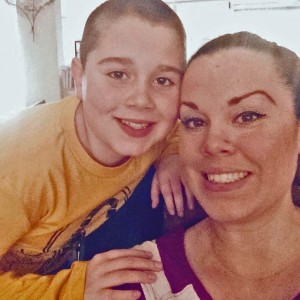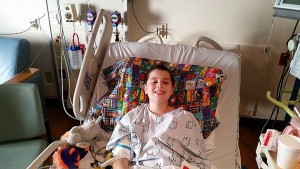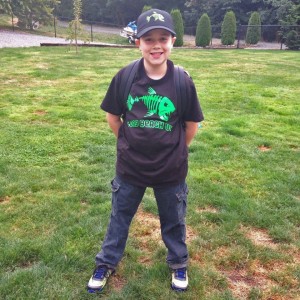
In honor of National Kawasaki Disease Awareness Day, we are sharing the story of William, a 10-year-old boy who lives with the disease, and why Seattle Children’s, an international leader in Kawasaki disease research, is the best place for children like William to receive treatment.
In September, Jennifer Bevaart’s son William developed a fever that lasted for days. He was lethargic, had a rash on his chest and his eyes were bloodshot. Over the next two weeks, Bevaart took William to at least four different specialists, each of whom suggested a different diagnosis: a sinus infection, walking pneumonia, bronchitis, even scarlet fever. Each treatment failed to ease William’s symptoms. He went from an active, tae kwon do enthusiast to a weak boy who was too weak to walk even the short distance to the mailbox without lying down to rest.
“Call it mother’s intuition, but I just knew something was very wrong with my son,” Bevaart said. “I felt like I was watching him die.”
Eventually, doctors determined William had Kawasaki disease, a serious illness that causes inflammation of blood vessels throughout the body. The disease affects about 7,000 children in the U.S. each year. It develops during childhood and most often affects young children under age 5.
When treated early, most children with Kawasaki disease can fully recover in a matter of days. If left untreated for about 10 or more days, Kawasaki disease can cause serious complications, including life-long aneurysms, stent placement, heart transplant, skin disorders and childhood anxiety. It is the most common cause of permanent heart disease in children.
Kawasaki disease is a puzzling illness, even to experts. There is currently no known cause, and diagnosing the disease can be challenging because the symptoms – which can include fever, a rash, swollen hands and feet, red eyes, swollen lymph nodes and red, swollen or cracked lips, mouth, throat and tongue – are unspecific and inconsistent.
Bevaart discovered few doctors are able to diagnose Kawasaki disease, and the longer it takes to diagnose a child, the less effective treatments can be.
“It took weeks to find out that William had Kawasaki disease, and as a result he’s still dealing with serious consequences of this disease,” she said.
Thankfully, children like William can come to Seattle Children’s for highly specialized care and access to clinical trials that aim to improve the diagnosis and treatment of this mysterious disease.
A unique clinical approach

Bevaart sought care for William at several hospitals before she was referred to Seattle Children’s, where her son is cared for by a team of Kawasaki disease experts in Seattle Children’s Kawasaki Disease Clinic.
The Kawasaki Disease Clinic, founded by cardiologist Dr. Michael Portman, brings together clinicians from pediatrics, cardiology and rheumatology who are experts in treating children with Kawasaki disease. This team approach benefits the nearly 600 Kawasaki patients who receive ongoing care at Seattle Children’s.
“I was instantly relieved as soon as I met with Dr. Portman,” Bevaart said. “His knowledge and expertise in Kawasaki disease was incredible. The whole team has been great with William. He actually looks forward to going to the hospital now!”
Advancing treatment for Kawasaki disease
The Kawasaki Disease Clinic gives patients and their families the opportunity to participate in national clinical research studies being led by Portman to improve diagnosis and treatment of this disease.
The current treatment for Kawasaki disease is intravenous gamma immunoglobulin (IVIG). IVIG is made from blood plasma and is given through an IV. This treatment can significantly reduce the risk of certain heart problems, but IVIG is effective in only 70% to 80% of cases. The remaining patients, including William, can suffer from ongoing fever and inflammation, and are at especially high risk for coronary artery disease.
Portman is working to improve outcomes by leading a clinical trial, sponsored by the U.S. Food & Drug Administration, which treats children with Kawasaki disease using the drug etanercept, commonly known as Enbrel, in addition to IVIG. Portman’s previous pilot study showed Kawasaki patients treated with both IVIG and etanercept had no recurrent fever and no new coronary artery inflammation. Even more patients in the study are now being treated with this protocol at six hospitals in the U.S. and Canada.
Searching for the cause
While the cause of Kawasaki disease is still unknown, Portman has developed an intriguing hypothesis that children who eat a significant amount of soy products could be at increased risk for Kawasaki disease. This could help explain why the disease is more common in Asian populations, particularly in Japanese children.
“Soy products are the richest sources of isoflavones, a plant hormone that resembles human estrogen,” Portman said. “These isoflavones could impair a child’s immune system and make them more susceptible to Kawasaki disease.”
Portman is also leading a study that analyzes soy consumption among children of different ethnic backgrounds in the U.S.
Looking at genetics
To better understand why some children develop Kawasaki disease and which patients will respond to routine therapy, Portman is leading another research study to analyze genetic factors. He has collected clinical data and DNA from nearly 600 patients with Kawasaki disease and their family members, including the Bevaarts. Portman is also using these samples and data to develop a diagnostic blood test for Kawasaki disease.
“We are thrilled to participate in research that could lead to better diagnoses and treatments for children like William,” Bevaart said.
Keeping up with the latest
To provide the best care for patients with Kawasaki disease, Portman and his team stay informed on the latest treatments and research being performed around the world. In February, Portman will present his latest research at the American Heart Association’s Eleventh International Kawasaki Disease Symposium.
Looking forward

William continues to face significant health challenges, but Bevaart is hopeful he will continue to benefit from the clinical care and research at Seattle Children’s. In the meantime, she is determined to increase awareness of this mysterious illness so other children might be diagnosed earlier than William.
“I encourage everyone to help raise awareness about Kawasaki disease,” Bevaart said. “We can’t change when William was diagnosed, but we can help other kids be diagnosed sooner. We can save someone else’s life.”
You can help fund Kawasaki disease research at Seattle Children’s by donating to the KD KIDS Guild at Seattle Children’s.
Families of children with Kawasaki disease are welcome to contact the Kawasaki Disease Clinic at 206-987-2015 for a referral, a second opinion or more information. They can also contact the Kawasaki Disease Research Program at [email protected] or 206-987-5153 for research information or participation.

